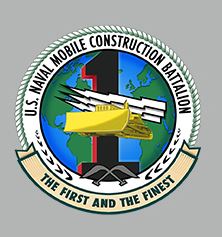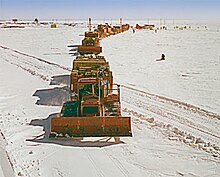Naval Mobile Construction Battalion 1
This article needs additional citations for verification. (February 2013) |
| Naval Mobile Construction Battalion 1 | |
|---|---|
 NMCB 1 insignia | |
| Active | 15 March 1942 – present |
| Country | United States |
| Branch | USN |
| Part of | 22nd Naval Construction Regiment |
| Homeport | Construction Battalion Center Gulfport |
| Nickname(s) | "The First and the Finest" |
| Engagements | World War II Vietnam War Gulf War Operation Enduring Freedom Operation Iraqi Freedom |
| Commanders | |
| Current commander | CDR Kemit Spears |

Naval Mobile Construction Battalion ONE (NMCB 1), is a United States Navy Seabee battalion. NMCB 1 has a long, proud and distinguished history as the very first Naval Construction Battalion of the service that would become known as the Seabees.
History
Commissioned on 15 March 1942 as Naval Construction Battalion 1. The Battalion was split into 2 Construction Detachments. The Second Construction Detachment went to Tongatabu and the Third Construction Detachment went to Elate, New Herbides.[1] The Seabee name did not exist when these groups deployed.[2]
World War II
By summer of 1941 civilian contractors were working on large naval bases at Guam, Midway, Wake, Pearl Harbor, Iceland, Newfoundland, Bermuda, and many other places. BuDocks decided there was a need to improve the Navy's supervision of these projects through the creation of "Headquarters Construction Companies". The men in these companies would report to the Officers in Charge of Construction and would be draftsmen and engineering aids needed for the administrative functions of the inspectors and supervisors overseeing the contracted work. These companies would consist of two officers and 99 enlisted men, but were not to do any actual construction. Rear Admiral Chester Nimitz, Chief of the Bureau of Navigation, authorized the formation of the first Headquarters Construction Company, on 31 October 1941. Recruitment started in November and as history would have it the company was formed on 7 December with the men undergoing boot training at Naval Station Newport, Rhode Island. By 16 December 1941, four additional companies had been authorized, but 7 December happened, plans changed and with them the ratings needed by a change in mission. The first Hq Construction Company provided the nucleus for the formation of the 1st Naval Construction Detachment sent to Bora bora. With the outbreak of war, Admiral Ben Moreell, Chief of BuDocks, recommended creating Naval Construction Battalions and on December 28th requested authority to carry this out. On 5 January 1942, he got the go-ahead from the Navy's Bureau of Navigation for the recruitment of construction tradesmen for those Batallions. When Admiral Moreell submitted his request to form those Battalions the other four Hq Construction Companies had been approved and authorized, so Hq Companies 2 & 3 were combined and enlarged to form the 1st Naval Construction Battalion.(and then were deployed as the 2nd & 3rd Construction Detachments) NCB One operated in the South Pacific for 23 months, mostly in the vicinity of the Tonga and Samoan Islands. During this time, various detachments built runways, base facilities, gun emplacements, fuel and oil storage tank farms as well as various other projects. With operations in the South Pacific drawing down, the Battalion was sent home and decommissioned in June 1944.
Post-war


In 1949, the Navy began an intense reorganization that included the creation of a new type of construction unit – the Mobile Construction Battalion. On 8 August 1949, U.S. Naval Mobile Construction Battalion One (MCB 1) was established at Naval Amphibious Base Little Creek, Virginia and was formally commissioned on 28 October of that same year.
Homeport changed for the Battalion in 1951 when it moved from Little Creek to Davisville, Rhode Island. During the ensuing years, the Battalion served at Puerto Rico; Guantanamo Bay, Cuba; Bermuda; Port Lyautey, French Morocco; Argentia, Newfoundland; and Rota, Spain. In 1956, the Battalion went to Antarctica and participated in Operation Deep Freeze II. During this time, NMCB One with its detachments was simultaneously employed on six continents. MCB One returned to Antarctica in 1961, this time to assemble a nuclear power plant[3] and work on 17 projects for which the Battalion received the Navy Unit Commendation.
Vietnam
NMCB One was the first Atlantic Fleet Battalion to take part in the Vietnam War. From 1966 to 1970, the Battalion made four consecutive deployments to Vietnam. During this time, four NMCB One members made the ultimate sacrifice serving their country. Their names were Constructionman Starkey, Steelworker 3rd Class Williams, Chief Builder McGinn, and Lieutenant Junior Grade Moscrip.
1970s through present


From the fall of 1971 through early summer of 1972, NMCB 1 was the second battalion to occupy and construct the BOIT station on Diego Garcia. They relieved Naval Mobile Construction Battalion 40, who had landed, nine months earlier, on the island by LSDs and LSTs. They constructed the facilities that MCB 1 would complete over their nine-month deployment. The runway that MCB 1's advanced party landed on in C130's was 3000 feet long. When MCB 1 left, the island the runway was 11,500 feet long and at final grade and compaction for the incoming MCB 62 to pour the 50-foot wide, 12-inch deep and 11,500-foot long final concrete runway. MCB 1 also constructed the concrete silos for the cement, that came in by ship, to pour the runway. MCB 1 also finished the aggregate piles by blasting the coral reef and mining the rock, crushing it and stock piling it for 62's use. The pile was over 500 feet tall, creating a mountainous hill on the island, whereas the average elevation had originally been 6.5 feet above sea level. The commanding officer for the unit then was P. Oliver Jr. and the XO was Comdr.. Perez. The main camp, CAMP Cushman, was named after the sailor who was standing watch at the water desalt barge when the steel plate cracked and dumped water on the red hot heater turning it into steam. Seaman Cushman was severely burned by the steam,and was air lifted out by British pilots at great risk. The camp was named for him posthumously .
In 1974 NMCB One was the last Battalion to deploy from Davisville. When the Battalion returned from Rota, it settled down in its new home at the Naval Construction Battalion Center.
NMCB One sent two details in 1990 to Saudi Arabia in support of Operation Desert Shield and Operation Desert Storm. The following year, the Battalion provided disaster relief following super typhoons on Guam and American Samoa. Upon returning to homeport in May 1992, the Battalion was again providing disaster relief, this time in South Florida in the aftermath of Hurricane Andrew. In December 1992, NMCB One redeployed from Rota to Somalia to conduct construction in support of Operation Restore Hope.
A 180-person detachment from NMCB One deployed to Bosnia-Herzegovina in December 1997 to support Operation Joint Guard. NMCB One returned to the Balkans when a 97-person detachment deployed to Kosovo in December 1999 as part of Task Force Falcon. During their 2000 European deployment, Detail Souda Bay conducted disaster recovery operations in remote Crete villages following torrential rains.
In June 2002, the Battalion deployed to Okinawa, Japan for the first time since 1987, where it performed various peacetime construction operations across the Pacific. Upon arriving in Okinawa, the Battalion immediately redeployed a 102-person Air Detachment to Basilan Island, Republic of the Philippines, in support of Operation Enduring Freedom. Under hostile conditions, the Air Det improved roads, drilled water wells, built bridges and base camps and rebuilt a dilapidated timber pier.
During its 2003–2004 Pacific Deployment, "The First and The Finest" made history by being the first NMCB to have deployed to two main-body deployment sites in Rota, Spain and on Guam. NMCB One performed peacetime construction operations in the Atlantic, European, Pacific and Central Command Areas of Responsibility, while simultaneously deploying its Air Det to Iraq in support of Iraqi Freedom. In September 2004, NMCB One performed disaster recovery operations at NAS Pensacola following Hurricane Ivan.
For its 2005 European deployment NMCB One and its details served in twelve countries throughout Europe, Africa, Asia, and the Caribbean, and once again deployed its Air Det to Iraq in support of Operation Iraqi Freedom. Immediately upon returning to homeport in August 2005, the Battalion commenced substantial disaster recovery operations in the aftermath of Hurricane Katrina.
In June 2006, NMCB One deployed to 20 sites in 9 countries as part of their Pacific deployment. The Battalion performed peacetime construction operations in Okinawa, Atsugi, Sasebo, Yokosuka, Iwakuni, Fuji, Chinhae, Pohang, Diego Garcia, Camp Pendleton, and San Clemente Island, contingency operations in Pohnpei, Indonesia, Philippines, and Afghanistan, and prison detainee operations in Iraq.
In September 2007, following a successful homeport, the Battalion deployed to 16 different sites throughout CENTCOM, PACOM, and NORTHCOM. NMCB One provided contingency construction and engineering in support of both Operation Iraqi Freedom II and Operation Enduring Freedom, in Iraq and Afghanistan. While supporting the mission in CENTCOM, the Battalion also conducted peacetime construction operations in Guam and San Nicolas Island (SNI), CA. Notably, the 120 Seabees in Guam and SNI redeployed to join the rest of the Battalion in support of the CENTCOM missions midway through deployment.
Awards: unit, campaign, service
A unit citation or commendation is an award bestowed upon an organization for the action cited. Members of the unit who participated in said actions are allowed to wear on their uniforms the awarded unit citation. The NMCB 1 has been presented with the following awards[4][5]
 Asiatic-Pacific Campaign Medal : - 1945
Asiatic-Pacific Campaign Medal : - 1945 World War II Victory Medal : - 1945
World War II Victory Medal : - 1945 Navy Unit Commendation: - Antarctica 1962
Navy Unit Commendation: - Antarctica 1962 Navy Unit Commendation : – 3 awards- - Vietnam 1968,69,70[6]
Navy Unit Commendation : – 3 awards- - Vietnam 1968,69,70[6] Navy Meritorious Unit Commendation - Vietnam
Navy Meritorious Unit Commendation - Vietnam Republic of Vietnam Civil Actions Medal Unit Citation
Republic of Vietnam Civil Actions Medal Unit Citation Republic of Vietnam Gallantry Cross with Palm Unit Award : - 4 awards
Republic of Vietnam Gallantry Cross with Palm Unit Award : - 4 awards Vietnam Campaign Medal service ribbon with 60– Device : - 8 awards
Vietnam Campaign Medal service ribbon with 60– Device : - 8 awards Vietnam Service Medal
Vietnam Service Medal Army Meritorious Unit Commendation: -1970
Army Meritorious Unit Commendation: -1970 Joint Meritorious Unit Award: - 1990-91
Joint Meritorious Unit Award: - 1990-91 Presidential Unit Citation (Philippines); - 2002 Exercise Balikatan 02-1
Presidential Unit Citation (Philippines); - 2002 Exercise Balikatan 02-1 Humanitarian Service Medal : – USA Hurricane Katrina 2005
Humanitarian Service Medal : – USA Hurricane Katrina 2005- Chief of Naval Operations Letter of Commendation 2009
 Meritorious Unit Commendation: - TF Iraqui Maritime 2010-11
Meritorious Unit Commendation: - TF Iraqui Maritime 2010-11 Army Meritorious Unit Commendation: - 2011-12
Army Meritorious Unit Commendation: - 2011-12 Battle Efficiency Award - 12 times[7]
Battle Efficiency Award - 12 times[7]- Peltier award : - 7 times[8]
See also
- Seabees
- Naval Mobile Construction Battalion 4
- Naval Mobile Construction Battalion (all NMCBs)
- Naval Construction Battalion Center Port Hueneme
- Amphibious Construction Battalion One (ACB-1)
- Amphibious Construction Battalion Two (ACB-2) – Naval Amphibious Base Little Creek#Major shore commands (at "Naval Construction Force")
References
External links
- Facebook NMCB1 [9]
- NMCB14 2004 OIFII Deployment
- NMCB 1 homepage
- Global Security
- Seabee Unit Histories [10]
- NAVDOCKS-100, January 1944, U.S.Naval Construction Battalion Administration Manual[11]
